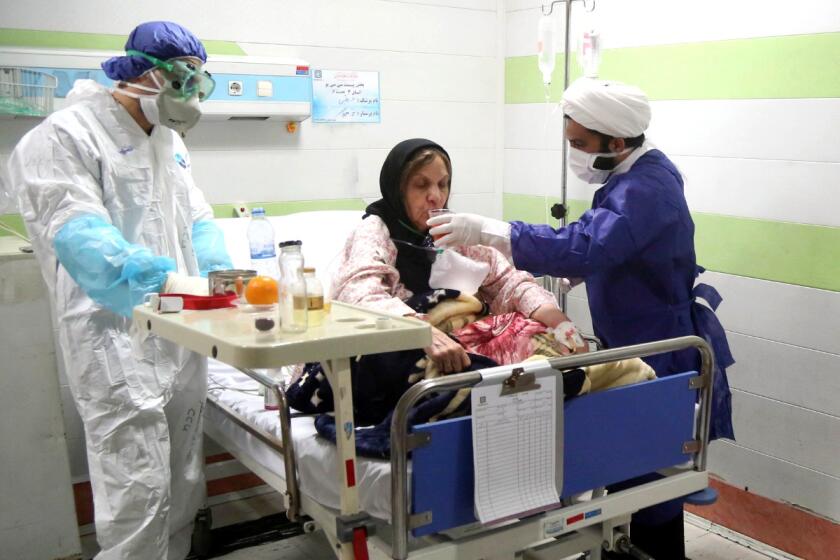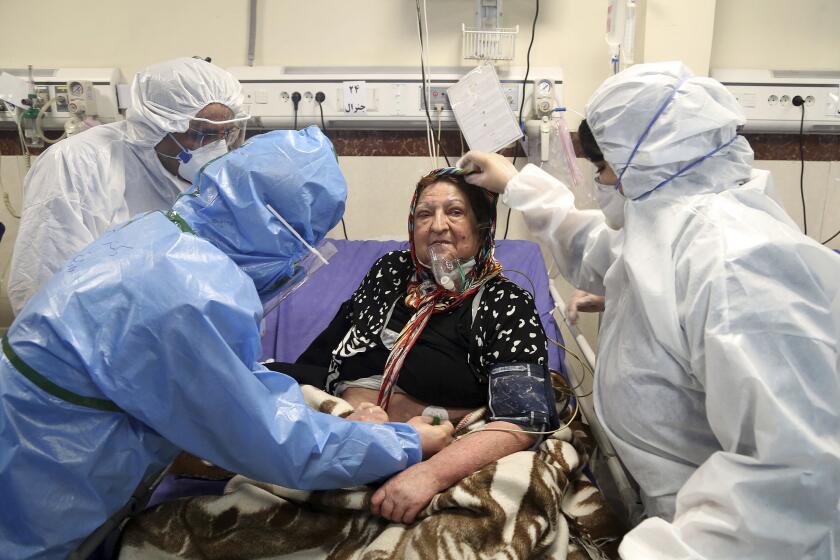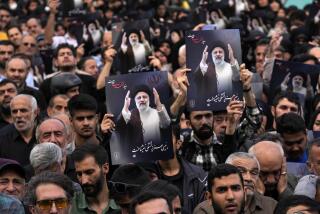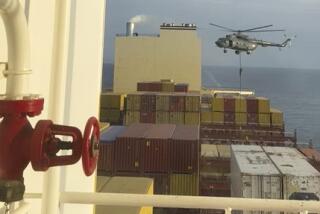Coronavirus becomes latest battlefront between Iran and the U.S.
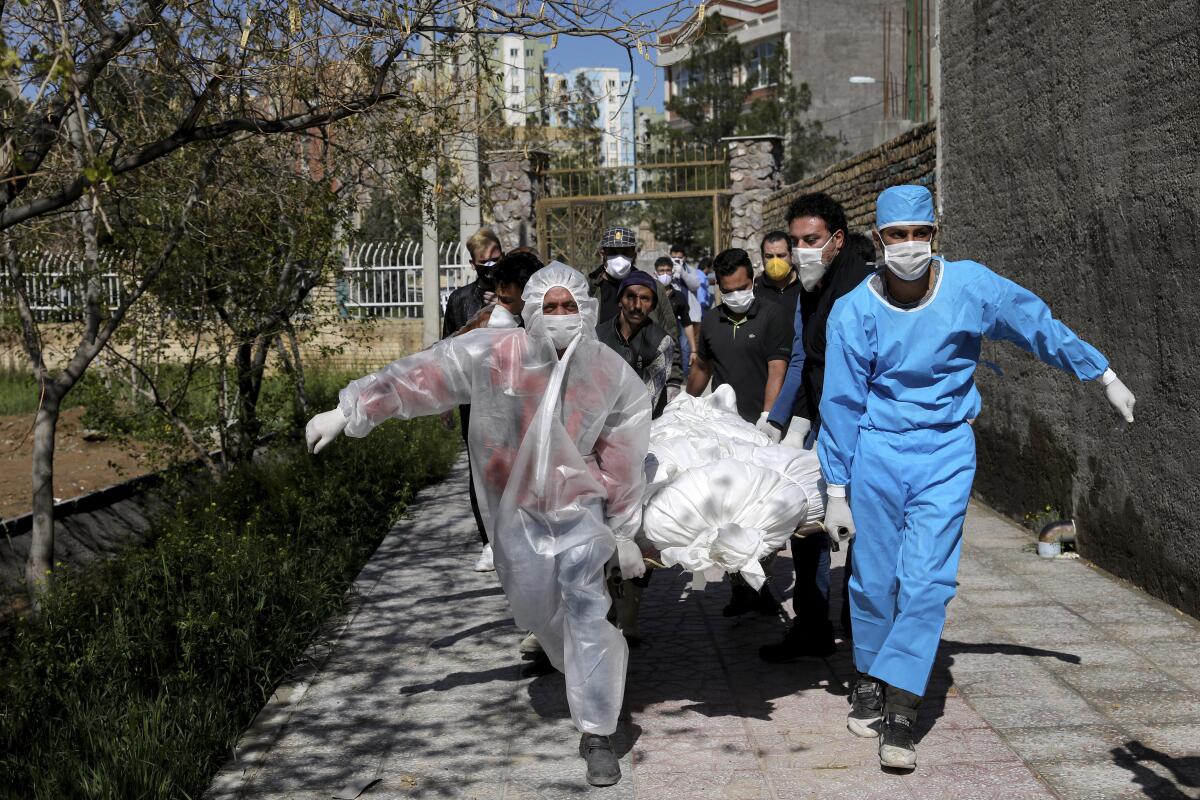
- Share via
DUBAI, United Arab Emirates — Even facing the same invisible enemy in the coronavirus, Iran and the United States remain locked in retaliatory pressure campaigns that have turned the pandemic into the two countries’ latest battlefront.
Initially overwhelmed by the outbreak, Tehran now seeks to sway international opinion on U.S. sanctions by highlighting its struggles with the coronavirus. Iran has asked for $5 billion from the International Monetary Fund even as it enriches uranium beyond the limits of its 2015 deal with world powers.
The U.S., which unilaterally withdrew from the deal in 2018 under President Trump, insists that aid can reach the Islamic Republic — though humanitarian organizations say Washington’s sanctions disrupt even permitted trade.
At the same time, the U.S. is now withdrawing troops from bases in neighboring Iraq, redeployments that it insists are pre-planned even though Trump alleges Iran is planning “a sneak attack” against them.
The risk of open conflict between the countries is overshadowed by the pandemic. Yet it persists — some say at levels as high as immediately after the January drone strike by the U.S. that killed Iranian Gen. Qassem Suleimani in Iraq.
After Suleimani’s killing, “everybody thought there will be war, but nothing happened,” said Mahsa Rouhi, a research fellow at the International Institute for Strategic Studies. “Whereas we were so close to war that it’s not that nothing happened. And we are not back to normal. ... We are back to a situation where any move could easily escalate into a conflict.”
Iran is one of the hardest-hit countries in the world in the coronavirus pandemic
The current tensions can seem trivial compared to the pandemic, which has infected at least 2 million people worldwide and killed more than 119,000.
The stakes, however, are anything but trivial. The night Iran retaliated for the Suleimani killing, it accidentally shot down a Ukrainian jetliner, killing all 176 people aboard. Allied Shiite militias in Iraq also continue to threaten U.S. forces deployed there in the aftermath of the fight against the Islamic State group.
Although largely silent in the initial days of the outbreak in Iran, Foreign Minister Mohammad Javad Zarif has begun a concerted campaign targeting American sanctions. It’s a way to absolve Iran’s civilian government of responsibility for an outbreak it hasn’t contained. But Zarif’s allegations of “medical terror” by the U.S. also highlight the challenge Tehran faces in accessing some medical supplies.
The U.S. says medical and humanitarian aid remains exempt, but Human Rights Watch says American laws as written affect Iran’s access to crucial equipment, “including ventilators, CT scanners, decontamination equipment and full-mask respirators.” Meanwhile, international firms remain leery of running afoul of U.S. sanctions even for authorized transactions with Iran.
“One of the problems for international aid has been to clarify the legal issues related to sanctions to ensure that medical supplies and medicines can be brought into Iran,” said Olivier Vandecasteele, Relief International’s country director for Iran, in a statement. “This slowed down the health response in the first weeks of the outbreak.”
A European system called INSTEX did get aid through, as has a Swiss channel. China also has contributed, as have regional Gulf Arab countries, which have the added worry that Iran will further spread the virus into their own nations.
At the same time, Iran insists it can produce masks and gloves, which the U.S. argues undercuts Tehran’s $5-billion request to the IMF. A loan from the IMF would be Iran’s first from the fund since 1962.
All this comes as Iran continues to produce low-enriched uranium with equipment and sites barred by the nuclear deal. Its nuclear program chief recently reiterated a threat that Iran could withdraw from the Nuclear Nonproliferation Treaty, though Iran didn’t showcase its program during its recent annual National Day of Nuclear Energy.
That bolsters suspicions of behind-the-scenes talks between intermediaries, particularly over the release of U.S. prisoners and other Westerners. Last week, Iran’s judiciary acknowledged ongoing prisoner-swap discussions but did not elaborate.
Overall tensions remain extraordinarily high. Online video and Iranian media reports suggest that Iran has deployed Fajr-5 missile batteries on beaches along the crucial Strait of Hormuz, the narrow mouth of the Persian Gulf through which a fifth of all oil traded in the world passes.
There have been reported maritime incidents in and around the strait as well. On March 27, two boats with a raised ladder approached a U.S.-flagged container ship, while Revolutionary Guard vessels approached a ship on April 2, according to private maritime security firm Dryad Global.
Then on Tuesday night, armed men boarded a Hong Kong-flagged tanker ship off the coast of Iran near the strait, holding the ship for a short time before releasing it. Suspicion immediately fell on the Guard, though Iran did not acknowledge the incident.
The U.S. Navy’s Bahrain-based 5th Fleet, which routinely has tense interactions with Iranian forces, declined to comment. Last summer saw a series of tense encounters at sea and on land that included the seizure of oil tankers.
In the battle for regional influence, coronavirus worries make Middle East countries vulnerable to disinformation campaigns.
The U.S. pressure campaign in part seeks to force Iran into spending at home rather than on its regional allies. Tehran views such groups as part of its defensive deterrence in the region.
Meanwhile, people continue to die of the virus in Iran. The pandemic could spread further into Middle Eastern countries allied with the U.S., which would force the world to continue working with Tehran, Rouhi said.
“At the end of the day, it’s still that bad actor that is governing a country of more than 80 million,” Rouhi said. “You don’t have an alternative.”
More to Read
Sign up for Essential California
The most important California stories and recommendations in your inbox every morning.
You may occasionally receive promotional content from the Los Angeles Times.
